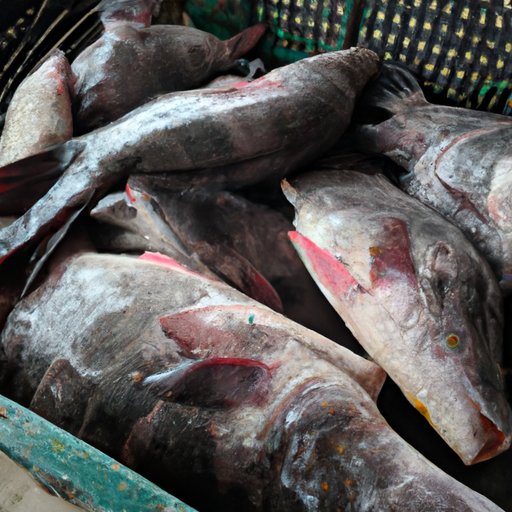Introduction
Basa fish is a type of catfish that is native to the Mekong and Chao Phraya river basins in Southeast Asia. It is a popular food choice due to its mild flavor and relatively low cost compared to other types of fish. But is basa fish healthy? This article will explore the nutritional profile of basa fish, its potential health benefits and risks, and the different varieties, markets, and preparation methods available.
Comparison of Basa Fish’s Nutritional Profile to Other Types of Fish
Basa fish is an excellent source of protein, with a 3-ounce serving providing 18 grams of protein. It also contains healthy fats, including polyunsaturated and monounsaturated fatty acids, which can help reduce inflammation and cholesterol levels. Basa fish is also a good source of essential vitamins and minerals, including vitamin B12, phosphorus, and selenium. Compared to other types of fish, such as salmon and tuna, basa fish has a slightly lower omega-3 content, but it still provides a significant amount of omega-3 fatty acids.
Exploring the Health Benefits of Eating Basa Fish Regularly
Eating basa fish regularly can provide numerous health benefits. The omega-3 fatty acids found in basa fish can help reduce inflammation, which can lead to a range of chronic health conditions, such as heart disease and arthritis. The high levels of protein and essential vitamins and minerals can also help improve cognitive function, bone and joint health, and overall wellbeing. Furthermore, basa fish is low in calories, so it can be enjoyed as part of a healthy, balanced diet.
Examining the Risks of Consuming Too Much Basa Fish
While there are many health benefits associated with eating basa fish, there are also some risks associated with consuming too much. For example, basa fish can contain high levels of mercury, which can be harmful if consumed in large amounts. Additionally, farmed basa fish can be contaminated with antibiotics and other chemicals used to treat the fish, which can have adverse effects on human health. Therefore, it is important to be aware of the potential risks associated with consuming too much basa fish.
An Overview of the Different Ways to Prepare and Cook Basa Fish
Basa fish can be prepared and cooked in a variety of ways. It can be grilled, baked, poached, steamed, or fried. When preparing and cooking basa fish, it is important to use fresh ingredients and cook the fish thoroughly to ensure that it is safe to eat. Additionally, it is important to avoid overcooking the fish to prevent it from becoming dry and tough.

Highlighting the Different Varieties of Basa Fish Available
Basa fish is available in a variety of forms, including farmed and wild-caught, fresh and frozen. Farmed basa fish is typically cheaper than wild-caught, but it may contain higher levels of contaminants, such as antibiotics and chemicals. Wild-caught basa fish is more expensive, but it is generally considered to be of higher quality and have fewer contaminants. Fresh basa fish is preferable to frozen, as it will have a better flavor and texture.

Understanding the Environmental Impact of Farmed Basa Fish
Farmed basa fish can have a negative environmental impact due to pollution from fish farms and overfishing of wild stocks. Pollution from fish farms can lead to water contamination and the destruction of marine habitats. Overfishing of wild stocks can lead to the depletion of fish populations, which can have a damaging effect on the environment. Therefore, it is important to consider the environmental impact when purchasing farmed basa fish.

Investigating the Different Markets Selling Basa Fish
Basa fish is widely available in local fish markets and online retailers. Local fish markets typically offer a wide selection of fresh and frozen basa fish, while online retailers often offer a more limited selection. Prices can vary depending on the type of fish, the size of the fish, and the supplier. It is important to do research before purchasing basa fish to ensure that it is of high quality and sustainably sourced.
Conclusion
In conclusion, basa fish is a nutritious and affordable option for those looking to include more fish in their diet. It is an excellent source of protein and essential vitamins and minerals, and it can provide numerous health benefits. However, it is important to be aware of the potential risks associated with consuming too much basa fish, such as mercury contamination and contamination from farm-raised fish. There are a variety of different ways to prepare and cook basa fish, and it is available in a variety of forms, including farmed and wild-caught, fresh and frozen. Finally, it is important to consider the environmental impact of farmed basa fish when making a purchase.
(Note: Is this article not meeting your expectations? Do you have knowledge or insights to share? Unlock new opportunities and expand your reach by joining our authors team. Click Registration to join us and share your expertise with our readers.)
